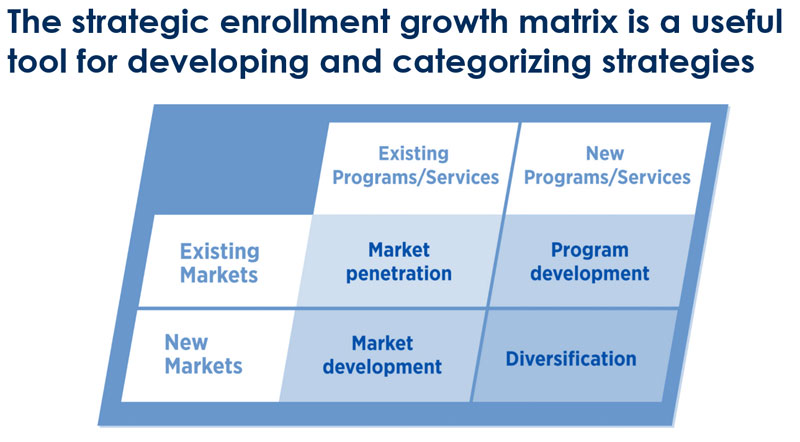enrollment
How Your Data Turns Into Strategies to Advance Enrollment
The Strategic Enrollment Planning Series
One of the things that has become increasingly clear since the beginning of the pandemic is that the strength of an institution’s strategic enrollment planning (SEP) process is a good predictor of how well it responds to unforeseen circumstances and shifts in the marketplace. Institutions with a dynamic and defined process are able to turn challenging situations into opportunities. They have the ability to swiftly change and adopt new ideas and strategies that enables them to succeed.
The institution’s situational analysis and strategy identification are the heart of the SEP process and represent the most pivotal steps. I’m going to walk through highlights and tips that can assist you in the execution of these critical components.
Note: These two critical steps follow the definition of scope and the establishment of key performance indicators and are followed by strategy prioritization, goal development, execution, and measurement (the subjects of future blogs in this series.)
Situation analysis
The situational analysis is a rigorous assessment of the institution and its environment at a given time. It is a narrative that defines the context in which the institution is operating. The objective is to enable stakeholders to identify changes needed to address the most pressing challenges that will ensure success in the future. It also allows the institution to understand whether or not its current situation aligns with the emerging needs and demand of the market it serves. An effective situation analysis requires the campus to have a data informed culture that seeks to define problems and opportunities by using a rich mixture of both narratives and quantified data.
Here’s how Heather Smith, associate vice president for advising and student services at University of Texas-El Paso describes how UTEP uses this process:
“UTEP has a very data informed culture, but not everyone was using data in the same way. We’re also a mission-driven campus, but many stakeholders didn’t always consider how data informed our mission and encouraged everyone to work toward that mission. The SEP process provided a uniform way to use data and gave us the opportunity to look outward to see how external factors were impacting our success. It gave us the opportunity to think outside of our own ecosystem and think about the broader world of not just higher ed, but the broader global context that has changed so much.”
As you work on your situational analysis, it is critical that it provides historical as well as comparator context. Comparator context facilitates measuring yourself against peer, aspirant, and competitor institutions and when combined with historical data, it enables you to see trends. Additionally, all of the narratives that are part of your situational analysis should tie back to key performance indicators for the institution. And lastly, it should create a direct link between identity, actions, and outcomes.
The depth and quality of your situational analysis will affects the development of sound strategies—the more in-depth it is, the higher the quality of your strategies will be. As you work through it, you will gain clarity about the areas that need work as well the opportunities for success. This then gives birth to the strategy development process, which connects the current state to the desired state of the institution—and hence it is the most exciting and collaborative part of SEP.
Debi Gaitan, vice president for student success at Northwest Vista College, describes how her college started their SEP process:
“Our SEP work came right after we began an intense focus on diversity, equity, inclusion, and justice. That work had broadened our understanding of the community college that we had created over the first quarter of a century. SEP helped us think critically if that was the community college that we needed to be over the next 25 years. We were missing opportunities to support our under resourced, impoverished community. All of that data was put to use in SEP to help move us forward. It also helped us identify extreme blind spots in where we were not representing the community.“
Strategy development
It is important to understand that there are two distinct levels of strategic thought: top level and second level. Top-level strategies are broad statements about what you are going to do and are usually generated by senior leadership. Second-level strategies bring focus and accountability to each of the identified top level strategies. For example, a top-level strategy could be, “RNL University will provide academic programs that attract new students.” A second-level strategy then could be something like “RNL University will develop a new Computer Science major”.
Categorizing Strategies: As you develop and consider strategies, it helps to categorize them. Ansoff’s growth matrix, which establishes that all organizations have four options for growth and stimulating demand, is what we use as we guide institutions through this process.
- Market Penetration: Refers to maximizing your current market share. Optimizing marketing, recruitment, and retention to gain a greater market share and hence experiencing growth as a result.
- Program Development: Focuses on introducing new academic or co-curricular programs that appeal to students in your existing market stimulating interest in students that wouldn’t traditionally consider you.
- Market Development: Refers to bringing existing programs into new markets. Taking a program online making it appealing to a new group of students that wouldn’t otherwise attend your institution is an example of this type of strategy.
- Diversification: Implies a brand new program to a brand new market. Failure rates under this option are higher. Ideally, if you can successfully operate on the other three growth quadrants, then you can avoid taking the risk associated with diversification strategies.

Form working groups
Lastly, the best way to start developing strategies is to form working groups that align with key areas of focus surfaced in the situational analysis. This allows stakeholders with specific and in-depth knowledge to bring their expertise to the process where it will help most. Some examples of working groups are competition group, enrollment group, marketing group, student composition group, capacity and demand group, financial group, diversity group, etc. These are the groups that will focus on developing second level strategies that the institution may undertake to build on strengths, address weaknesses, take advantage of opportunities, or prepare for threats. The groups are responsible for making sure that every strategy has an action plan tied to it. The action plan defines who is going to do it, timeline, budget, the impact of it, and measurement of effectiveness.
Watch our session from the SEP Forum and contact us for a free consultation
Debi Gaitan and Heather Smith presented with me at our 2021 SEP Executive Forum. You can watch our session below, and get free access to all the SEP Forum sessions by reaching out to talk with an RNL expert.
Watch the sessions from the 2021 Strategic Enrollment Planning Forum
Request a consultation with an RNL enrollment expert and you’ll receive free access to the sessions from the 2021 SEP Executive Forum. Dive into four hours of strategies and insights from enrollment leaders, and then discuss your challenges and goals with an RNL expert.
